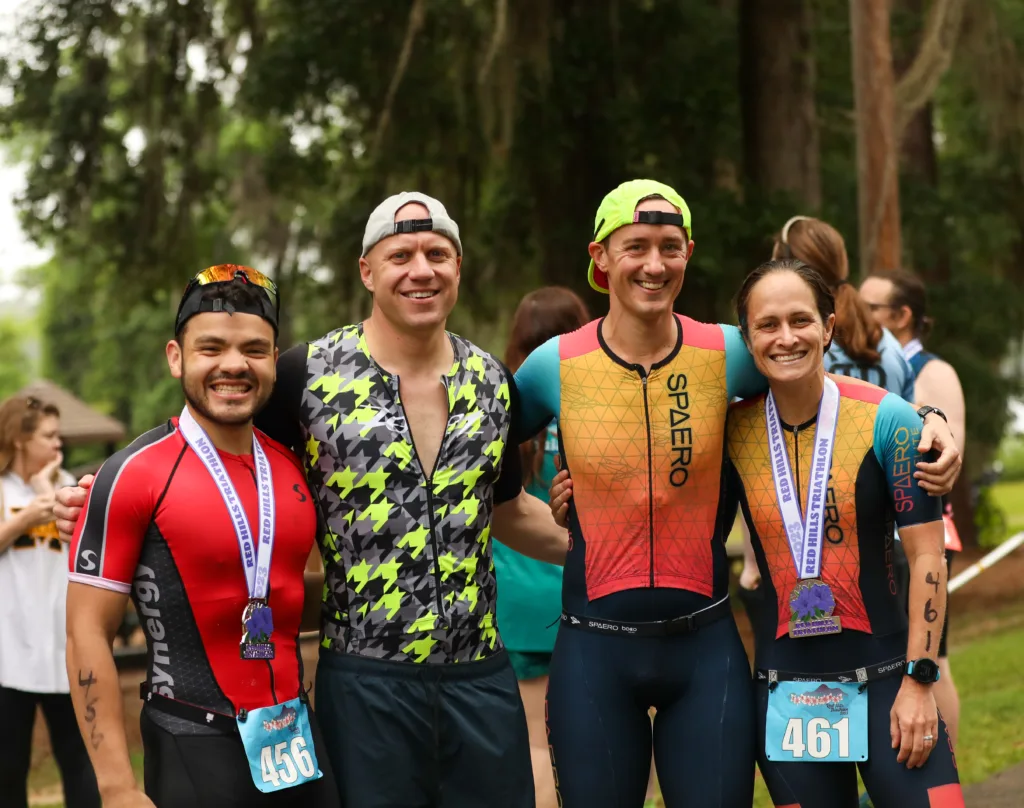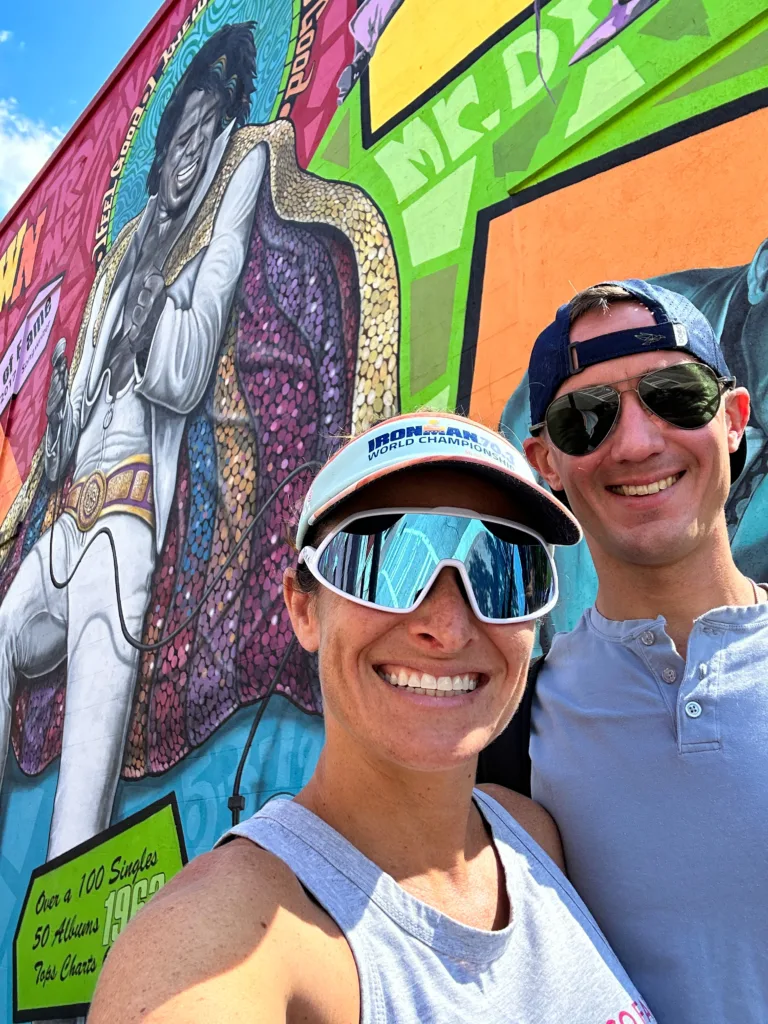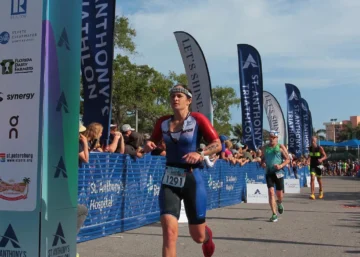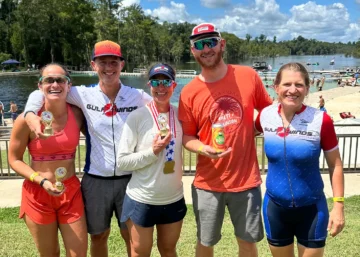
Do you plan your triathlon season ahead of time? Typically, my husband and I meet with our coaches in December-January to plan out a race calendar for the following year. This way, they have a pretty good picture of what the race season will look like and they can set up our training schedule accordingly, so we peak at the right time and stay healthy.
The process starts with selecting A, B, and C races.

What are A, B, and C races?
A race- This is the most important race on your calendar. It’s the one you want to nail. The majority of your training focus will be on this race and others that support it.
B race- These are races you want to do well at, but they’re not as important as the A race. B races can serve as test events as a good way to measure fitness and practice skills ahead of an A race.
C race– These are races that you incorporate for fun around your more important A and B races. Sometimes, we use C races within a training block to provide some intensity, practice racing, or just to have fun with friends.
First, we pick our A race and then we work backwards to select B races that support it. Then, we sprinkle in a mixture of C races, as based on local events that we enjoy doing in the community.
For example, my A-race last year was IRONMAN Florida. Based upon that goal, we decided to do 70.3 Chattanooga in May and then 70.3 Augusta in September. Then, we added some local sprints and cycling events as C races. It’s ok to have some room for flexibility in the schedule, if you want to add a fun short course race later in the year, but it’s important to have the basic framework planned out ahead of time.
Can you have more than one A race in a season? If they’re far enough apart. For example, 70.3 Chattanooga is an early season race, so that it was the primary focus from January to May. Then, IRONMAN Florida is at the end of the year, so it was the main focus from June to November. But I won’t have more than two A races in a year.

Common mistakes when planning a triathlon season
1- Not planning at all- Some people like to wait until their friends sign up for their races before making any plans for the year. That’s fine, if it works for you, but you’ve got to have reasonable expectations about what you can achieve in a shortened time frame. Panic training for a race isn’t really fair to you or your coach.
2- Racing too much– This is individual to each person, but there are obvious examples on social media these days. It’s the post that sounds like: “2 weeks post IRONMAN Texas! Decided to enter a local half marathon, because I was feeling great. Gearing up for my next 70.3 in 3 weeks, and then I have a marathon 2 weeks after that…”
You might be able to get away with that type of packed schedule if you’re a professional athlete, but it’s a recipe for disaster if you’re a normal human being. Likely, the next post you’re going to see is, “Been having nagging hip pain for a few weeks… ” Insert- hit head with palm of hand emoji- here.
We rarely do more than one race a month, because then we’re spending too much time racing and not training. At the most, we’ve done two sprint triathlons in one month, a sprint/Olympic triathlon and a run race in one month, and I think I did an Olympic 4 weeks or so before a 70.3. Running races are a bit different in that you can do more, but there’s still a limit to how your body can race, recover, resume training, taper, and then race again. Squeezing it into a compressed timeline is a great way to get injured.
3- Not setting ABC expectations for races- Your body can only produce so many peak performances in a year. It’s something I learned when I showed horses. We’d gear up for a World Championship in June, so that’s where the horse needed to perform at its absolute best. We’d do a lot of smaller events in the months leading up to the big show. However, this was with the understanding that we couldn’t “ask the horse for its life” at every local show we went to. If we made that mistake, this would be the result: a horse that peaked too early and rode crappy by the time the Championship rolled around, an angry horse because you asked it to give 110% every weekend, or an injured horse. It’s the same thing with athletes.
It might sound great to do three 70.3 races, a World Championship, USAT Nationals, and all the fun local events, but do you have realistic A, B, and C expectations for all those races? Or are you expecting to have an A race every time you compete?
See real-time metrics while you swim with an in-goggle display: time, distance, pace, stroke rate, and more. Choose from a library of workouts and training plans or upload your own custom workout.
- 16 hours of swimming on a single charge
- Anti-fog coating, 7 nose pieces, and silicone eye seals
- 2 year warranty
- Premium features- HeadCoach, Swim Straight, Training Peaks integration, Open Water Mode with heart rate
How to pick triathlon races
1- Time of year- When selecting an A race, I think not only about the actual race date, but also what time of year I’ll be training for that race, as it relates to things like work, family obligations, and even weather.
2- Type of course- Does the course profile suit my strengths for what I want to achieve? I picked IM FL for a few reasons. It had an ocean swim, and I’m a strong swimmer. I have great endurance on the bike, so I could handle the windy conditions. It was my first marathon, so we wanted a flat course.
3- Training partners- The benefit of signing up for races that your friends are doing too is that you have built in training partners! Even if you have different coaches, everyone follows the same basic schedule when gearing up for a race like a 70.3 or full Ironman.
4- Location- If you can’t drive to the race, you have to plan for how you’re going to get your bike there. Do you need to buy a bike box so you can take it on the plane if you have to fly? Races that are farther away add a layer of complexity and sometimes stress.
5- Budget- This is another reason to pick A, B, and C races. We pick our most important race first (the one we really want to do) and then we look at a few essential B races to prepare. Then, we add some C races for fun. While it would be great to do a sprint triathlon every month, we’d rather invest that money in bigger races that are more important to us than doing every race under the sun.
6- Coaches input- I’ve recently learned that this isn’t something everyone does… which is mind-boggling to me. If I’m paying my coach for his/her advice, then I’m going to ask his/her opinion about my plan for my race schedule. If my coach says, “Well, I don’t think that’s a great idea to do this race on top of this race for X, Y, Z, reason,” I listen. Clear communication is the key to having a successful coach-athlete relationship (or any relationship come to think of it.)

By planning our triathlon race season ahead of time, we have a complete picture of what the year will look like in advance, which helps our coaches prepare and gives us the best shot at achieving our goals. This is how we do it, and hopefully it helps give you an idea on how to plan out your race season too!



